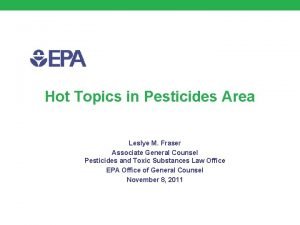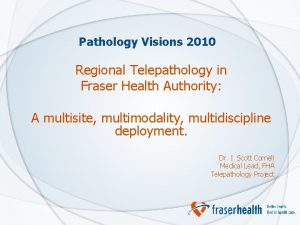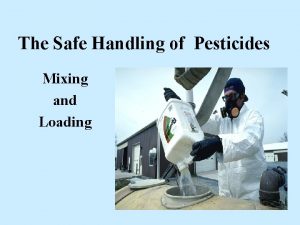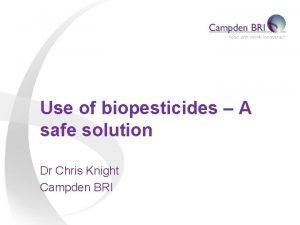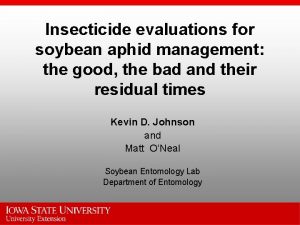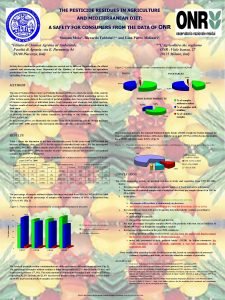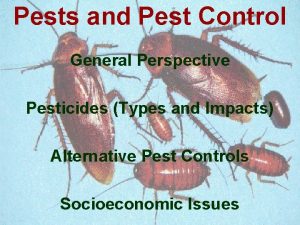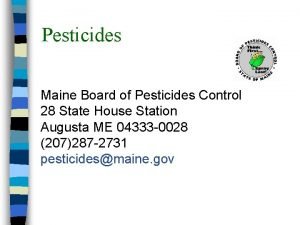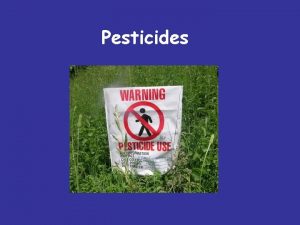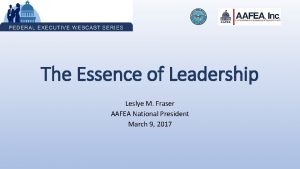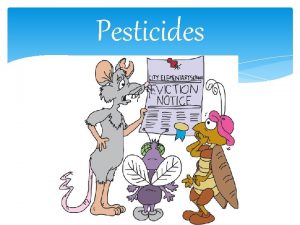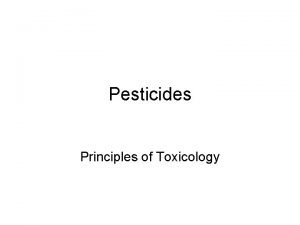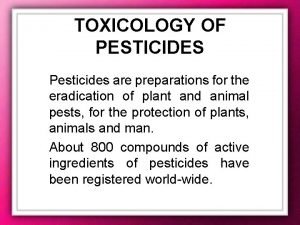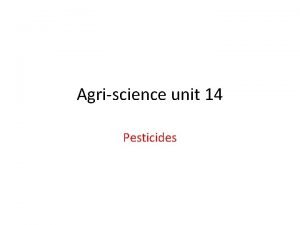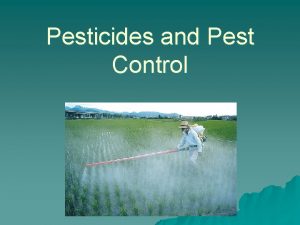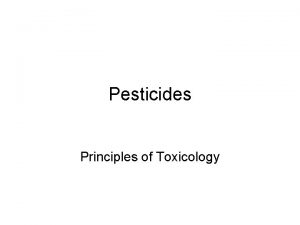Hot Topics in Pesticides Area Leslye M Fraser
















- Slides: 16

Hot Topics in Pesticides Area Leslye M. Fraser Associate General Counsel Pesticides and Toxic Substances Law Office EPA Office of General Counsel November 8, 2011

Topics to be Covered • Pesticide General Permit • ESA Cases • Recent Tolerance Decision • Rodenticide Cancellation 2

EPA Pesticide General Permit • On October 31, 2011, EPA issued a final NPDES Pesticide General Permit (PGP) for point source discharges from the application of biological pesticides, and chemical pesticides that leave a residue to waters of the United States. • PGP covers Operators that apply pesticides that result in discharges from the following use patterns: – – mosquito and other flying insect pest control; weed and algae control; animal pest control; and forest canopy pest control • http: //cfpub. epa. gov/npdes/home. cfm? program_id=410 3

PGP Continued • The permit requires permittees to minimize pesticide discharges through the use of pest management measures and monitor for and report any adverse incidents. • Some permittees also are required to submit a noticeof-intent (NOI) prior to beginning to discharge and meet additional permit conditions, as well as recordkeeping and reporting requirements. 4

PGP Continued • While the permit requirements must be met as of October 31, 2011, Operators will be covered automatically under the PGP without submitting an NOI for any discharges before January 12, 2012. • To continue coverage after January 12, 2012, those Operators who are required to submit NOIs will need to do so at least 10 days prior to January 12 (or 30 days for discharges to National Marine Fisheries Service (NMFS) Listed Resources of Concern). 5

PGP Continued • The PGP provides coverage for discharges in the areas where EPA is the NPDES permitting authority, which includes six states, * DC, most U. S. territories, Indian country lands, and many federal facilities. * Alaska, Idaho, Massachusetts, New Hampshire, New Mexico, and Oklahoma • In the remaining 44 states (and the Virgin Islands), the states are authorized to develop and issue the NPDES pesticide permits. • For the first 120 days that the permit is in effect, EPA will focus on providing compliance assistance and education of the requirements, rather than on enforcement actions. 6

ESA – Recent History • Washington Toxics Coalition v. EPA – led to NMFS consent decree to issue Bi. Ops by 2012 for 37 pesticides EPA had determined “may affect” listed salmonids – Nov. 2008 - NMFS issued the 1 st Bi. Op (Op Bi. Op) – April 2009 - NMFS issued the second Bi. Op (Carbamate Bi. Op) – EPA developed an implementation plan for the Op Bi. Op that the registrants rejected • April 2009 – Dow. Agro files suit against NMFS that Op Bi. Op is flawed; court decision issued last week gives deference to NMFS and affirms Bi. Op • Nov. 2010 – Northwest Coalition for Alternatives to Pesticides files suit against EPA for failure to implement the RPA’s and RPMs in the two Bi. Ops; case currently stayed under Dec. 30 th (pending decision in Dow v. NMFS case). 7

ESA – NAS Study • NAS Ecological Risk Assessment Under FIFRA and ESA – study of underlying science issues and methodology jointly funded by EPA, NMFS, DOI, and USDA. • Topics NAS will consider to extent practicable include: – – – Best available scientific data and information Sub-lethal, indirect, and cumulative effects Mixtures and inerts Models Interpretation of Uncertainty Geospatial Information and Datasets • First public meeting was Nov. 3 rd; final report expected around Fall 2012. http: //www 8. nationalacademies. org/cp/projectview. aspx? key=49396 8

ESA Megasuit • On January 20, 2011, CBD and PANNA filed a complaint alleging that EPA violated the ESA by failing to initiate consultation with FWS and NMFS regarding the effects of EPA-registered pesticides on endangered and threatened species throughout the US. • Plaintiffs identified over 300 pesticides that they allege may affect over 200 endangered or threatened species or their critical habitats. • Plaintiffs seek declaratory and injunctive relief, including appropriate interim relief. 9

Megasuit Continued • American Chemistry Council, American Farm Bureau Federation, Crop. Life America, and Reckitt Benckiser filed motions to intervene. • The parties have had six meetings to explore the possibility of settlement between May and November. The current stay expires on November 18, 2011, and the court has ordered the parties to submit a joint status report on November 10, 2011. 10

ESA Continued • CBD v. FWS & EPA. (ND Cal. ) - recently filed case alleging unreasonable delay in the completion of consultations regarding the effects of over 60 pesticides on the California red-legged frog. • Council for Endangered Species Act Reliability v. Jackson (D. AZ) -- case challenges EPA's failure to consult with FWS under the ESA on the 2007 rotenone reregistration decision (the RED). – In October, the Court rejected EPA's motion to dismiss on jurisdictional grounds and invited EPA to refile as a motion for summary judgment. – EPA believes there are no jurisdictional facts requiring further discovery and that the challenged RED cannot be reviewed by this court, and thus recently moved for reconsideration. 11

DDVP Tolerance Decision • NRDC filed petition seeking revocation of all DDVP tolerances raising numerous issues that EPA found lacking in merit. In objections to EPA’s denial of its petition, NRDC argued the following: – EPA’s decision on the children’s safety factor was flawed; and – EPA improperly relied on a human study. • NRDC also requested a hearing on its objections; EPA denied both the objections and the request for a hearing. The hearing denial primarily was based on fact that issues were raised for the first time on appeal. 12

DDVP Tolerance Decision • NRDC appealed to the 2 d Circuit; briefing and argument in the case focused primarily on the hearing issue. In a unanimous decision, the Court held: – The statute does not compel retention of the children’s safety factor in the absence of data under the endocrine disruptor screening program; – The case had to be remanded to EPA because EPA had not explained how its decision on the children’s safety factor took into account the completeness of the toxicity and exposure data and potential pre- and post-natal toxicity; and – It did not need to resolve the question of whether NRDC was entitled to a hearing on its human studies claims because EPA on remand might render issues regarding the human study irrelevant to the case. 13

Rodenticide Cancellation • As a part of the reregistration process in FIFRA § 4, on May 28, 2008, EPA issued its Risk Mitigation Decision for Ten Rodenticides (RMD). • The RMD identifies risk mitigation measures that EPA concluded would appropriately balance the benefits of rodenticides against the risks they present and that, if adopted, would enable those rodenticide products to be eligible for reregistration. 14

Rodenticide Cancellation • EPA recognized that it would take time for registrants to design and implement the risk mitigation measures identified in the RMD, and therefore allowed registrants a period of almost 3 years to continue distributing and selling existing registered products. • That period ended June 4, 2011, and within that time, most rodenticide registrants developed and are now marketing RMD-compliant products. 15

Rodenticide Cancellation • Four registrants have refused to voluntarily improve a portion of their products, and EPA is now in the preliminary stages of bringing cancellation actions pursuant to FIFRA section 6(b) against those products. • On September 7, 2011, EPA published in the Federal Register notice that it was convening a 3 -day meeting of the SAP beginning Nov. 29 th concerning the proposed rodenticide cancellations. 76 FR 55381. 16
 Leslye fraser
Leslye fraser Map of fraser valley health region
Map of fraser valley health region Hot topics in networking
Hot topics in networking Hot topics in networking
Hot topics in networking Hot topics in leadership
Hot topics in leadership Hot topics in sports nutrition
Hot topics in sports nutrition Histology job
Histology job Hot topics in patent law
Hot topics in patent law Safe handling of pesticides
Safe handling of pesticides Biopesticides examples
Biopesticides examples Soybean aphid pesticides
Soybean aphid pesticides Mediterranean diet pesticides
Mediterranean diet pesticides How pesticides work
How pesticides work Pros and cons of pesticides
Pros and cons of pesticides Integrated pest management ____ than pesticides.
Integrated pest management ____ than pesticides. Different types of pesticides
Different types of pesticides Maine board of pesticides control
Maine board of pesticides control
